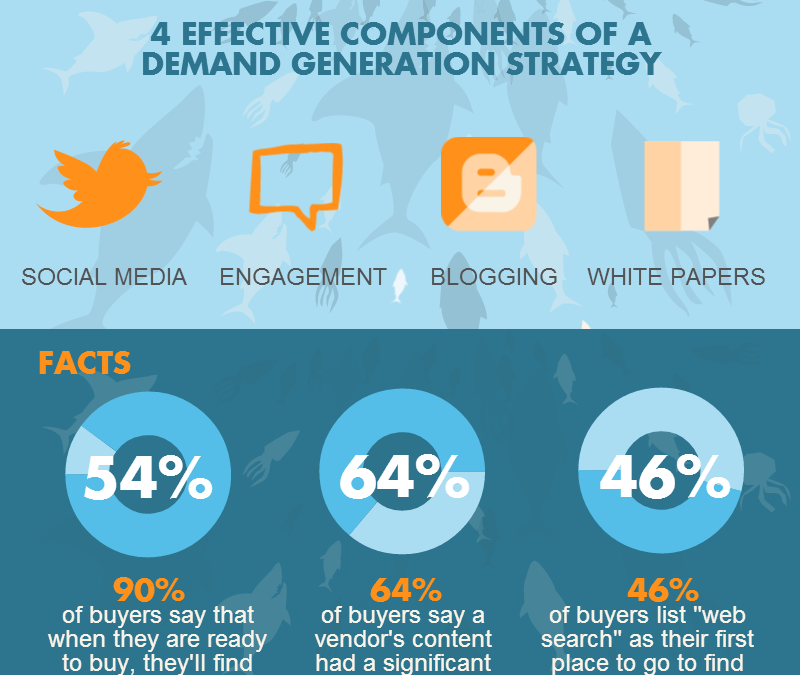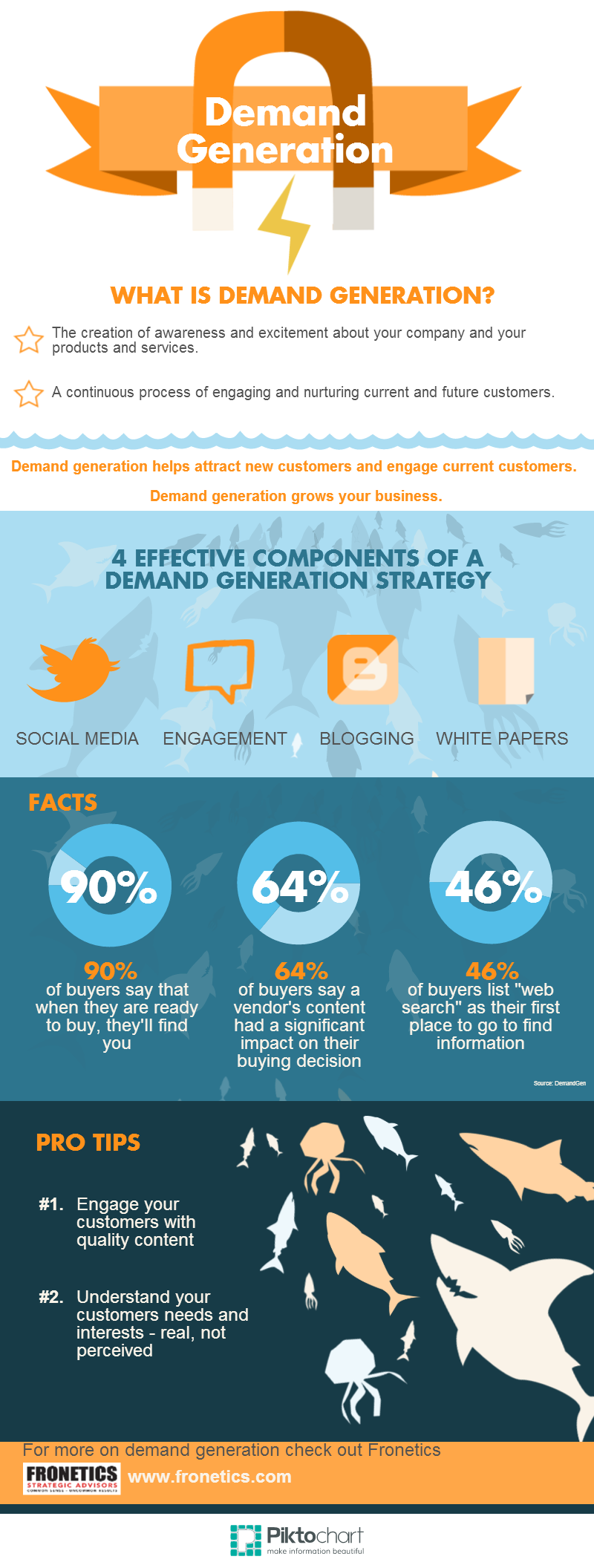
by Fronetics | Feb 12, 2015 | Blog, Content Marketing, Marketing, Strategy

7 steps to a blogging strategy for your business.
Blogging has proved to be a successful marketing strategy for many companies. In fact, a full 82 percent of companies who blog daily day have acquired a customer from their blog. Freight logistics company Cerasis acquired 98 new customers by leveraging their blog and digital strategy.
What does it take to attract prospects and acquire customers? Strategy. A 2014 study of B2B marketers found that companies who have a documented content strategy in place are more likely to consider their efforts to be effective than companies who do not have a documented strategy in place (60 percent vs. 11 percent).
Here are 7 steps to follow to develop a blogging strategy for your business.
1. Understand the ‘Why’.
The first step in the development of your blogging strategy will serve as the foundation for all remaining elements. Defining the purpose of your blogging activities and communicating them to your team will create a clear path to successful implementation. Understanding the purpose of your blogging activities means being able to answer two important questions: Why has your company decided to blog? What is it hoping to gain? Setting the strategy for your blog starts with understanding the reasons and motivations for prioritizing blogging as a marketing strategy.
2. Let your ideal customers define content.
Content will be the backbone of your blogging operation. Since you are likely targeting ideal customers with this content in order to convert them to leads, it stands to reason that you should look to them for content inspiration. Building out hypothetical profiles of your ideal customers will allow you to answer important questions such as their pain points, challenges, demographics, and job duties. Use what you know about the buying and researching behaviors of your ideal customers to craft relevant and interesting content they’d likely be searching for. Above all, publish nothing less than your most quality content. Part of building your reputation as a trusted industry thought leader is setting – and continuing – to meet expectations. You’re better off missing one day of a blog post than phoning in something that has the potential to undermine the credibility of your company.
Keywords signal to search engines when there’s a match between your content and the search term of a user. Similar to crafting content with your ideal customer in mind, keywords should be tailored to phrases your ideal customers use to research and buy. Determine which keywords you’ll be targeting and then draft a list of 5-10 keywords and associated long-tail keywords you will include in blog content.
4. Identify content distribution activities and platforms for promotion.
Once you’ve determined strategy for content creation and optimization, it’s time to make a plan to get your quality content in front of potential customers. It’s not enough to just post and pray that you’ll be found – you should actively distribute and promote blog content. Fortunately, the proliferation of social media has made it easier for companies to reach their target audiences, but not without competition. Reusing blog posts and repackaging content in different forms – such as infographics, summary tweets, & photos – will help break through the noise of competitors.
5. Assign responsibility.
Decide what your day-to-day blogging operations will look like. Who will be accountable for each function of your blogging strategy? The size and resource availability of your organization is likely to determine how centralized blogging responsibilities will be. When thinking about responsibilities, consider tasks beyond just writing posts; responsibility for tasks such as publishing and promoting content, drafting an editorial calendar, and analyzing data will all need to be assigned.
6. Maintain an editorial calendar.
Analogous to a roadmap, an editorial calendar will guide your blogging activities and give you a big picture look at where you’re headed and how you’re getting there. It also serves to hold those with blog-related responsibilities accountable to a publishing schedule. And while it’s true that the frequency of blog posts can be linked to an increase in website traffic, stepping outside of what you can reasonably commit to is a recipe for disaster.
Use your editorial calendar to set the number of blog posts you’ll publish each week to ensure posts are published with consistency and regularity. That not only establishes routine for your team, but also for your readers. Get started now with this template for creating your own editorial calendar.
7. Measure, analyze, adapt, and repeat.
Determine what your blogging success will look like and use relevant tools to regularly track and monitor metrics. Include metrics from all platforms of distribution, not just website page views or traffic. Think in terms of retweets, follows, likes, and subscribers. Set, review, and revisit goals consistently. Modify approaches that aren’t working. This on-going analysis keeps blogging efforts nimble, which is particularly helpful when outside factors make changes in blogging objectives necessary.
Develop and implement a well-thought-out blogging strategy. Using quality blog content to find, connect, and engage potential customers online can quickly become your powerhouse marketing activity.
Interested in learning more about how your business can develop a winning blogging strategy? We can help. We are a consulting firm focused on inbound marketing and strategy.


by Fronetics | Feb 10, 2015 | Blog, Content Marketing, Marketing, Strategy

You’ve likely heard it before – your business should be blogging. It’s understandable if it isn’t. Given the finite nature of a single workday, we all face daily pressure to prioritize projects and streamline strategies. But isn’t it true that our priorities should align with activities that have the most significant impact on performance? When data becomes the guide to choosing where to focus marketing efforts, it becomes clear that blogging is the powerhouse of digital marketing activity.
Blogging positively impacts a number of typical objectives for businesses. It makes it more likely for companies to be found in search engine results, produces higher quality leads, establishes industry expertise, and shortens sales cycles. To understand exactly to what degree blogging is affecting these outcomes, let’s take a look at the data.
Blogging generates high-quality leads and increases sales.
Practically all marketing activities ultimately seek to drive one objective – to increase sales. Many businesses are tying big sales wins to their blogging efforts. In a 2013 publication of Marketing Benchmarks, HubSpot reported companies that blog once or twice per month generate 70 percent more leads than those who don’t blog at all. Further, companies nearly double their sales leads by increasing blogging frequency from 3-5 times per month to 6-8 times per month.
Blogging drives increased website traffic.
Increased website traffic can almost always be linked to an increase in leads and sales. Companies with 51-100 pages on their website generate 48 percent more traffic than those with 1-50 pages according to the same HubSpot report. Consistent blogging activity builds the number of website pages and consequently the number of opportunities for your company to connect with customers, leads, and industry peers. Publishing frequency matters, too. Companies that blog at least 15 times per month get five times more traffic than those that don’t blog. Small businesses with 1-10 employees see the largest gains by posting more often.
Blogging links businesses and customers.
Business websites with blogs have 434 percent more indexed pages and 97 percent more indexed links based on the findings of a 2013 Social Media Today report. If search engines can easily find your business, prospective customers will find you easier, too. Building links ensures existing and potential customers can connect and engage meaningfully with your company.
Blogging seeks to educate and establish expertise.
Crafting and publishing quality blog content builds credibility and trust. Social Media Today reports a full 70 percent of consumers learn about companies through articles rather than ads and that 61 percent of consumers have made a purchase based on a blog post.
Data makes it clear that relevant and engaging blog content is a valuable marketing asset and sales driver for many businesses. In fact, marketers who have prioritized blogging are 13 times more likely to enjoy positive ROI. Is your company taking full advantage of this powerhouse marketing activity or is it missing opportunities to attract leads and delight customers?

by Fronetics | Feb 10, 2015 | Blog, Content Marketing, Marketing, Strategy

You’ve likely heard it before – your business should be blogging. It’s understandable if it isn’t. Given the finite nature of a single workday, we all face daily pressure to prioritize projects and streamline strategies. But isn’t it true that our priorities should align with activities that have the most significant impact on performance? When data becomes the guide to choosing where to focus marketing efforts, it becomes clear that blogging is the powerhouse of digital marketing activity.
Blogging positively impacts a number of typical objectives for businesses. It makes it more likely for companies to be found in search engine results, produces higher quality leads, establishes industry expertise, and shortens sales cycles. To understand exactly to what degree blogging is affecting these outcomes, let’s take a look at the data.
Blogging generates high-quality leads and increases sales.
Practically all marketing activities ultimately seek to drive one objective – to increase sales. Many businesses are tying big sales wins to their blogging efforts. In a 2013 publication of Marketing Benchmarks, HubSpot reported companies that blog once or twice per month generate 70 percent more leads than those who don’t blog at all. Further, companies nearly double their sales leads by increasing blogging frequency from 3-5 times per month to 6-8 times per month.
Blogging drives increased website traffic.
Increased website traffic can almost always be linked to an increase in leads and sales. Companies with 51-100 pages on their website generate 48 percent more traffic than those with 1-50 pages according to the same HubSpot report. Consistent blogging activity builds the number of website pages and consequently the number of opportunities for your company to connect with customers, leads, and industry peers. Publishing frequency matters, too. Companies that blog at least 15 times per month get five times more traffic than those that don’t blog. Small businesses with 1-10 employees see the largest gains by posting more often.
Blogging links businesses and customers.
Business websites with blogs have 434 percent more indexed pages and 97 percent more indexed links based on the findings of a 2013 Social Media Today report. If search engines can easily find your business, prospective customers will find you easier, too. Building links ensures existing and potential customers can connect and engage meaningfully with your company.
Blogging seeks to educate and establish expertise.
Crafting and publishing quality blog content builds credibility and trust. Social Media Today reports a full 70 percent of consumers learn about companies through articles rather than ads and that 61 percent of consumers have made a purchase based on a blog post.
Data makes it clear that relevant and engaging blog content is a valuable marketing asset and sales driver for many businesses. In fact, marketers who have prioritized blogging are 13 times more likely to enjoy positive ROI. Is your company taking full advantage of this powerhouse marketing activity or is it missing opportunities to attract leads and delight customers?





